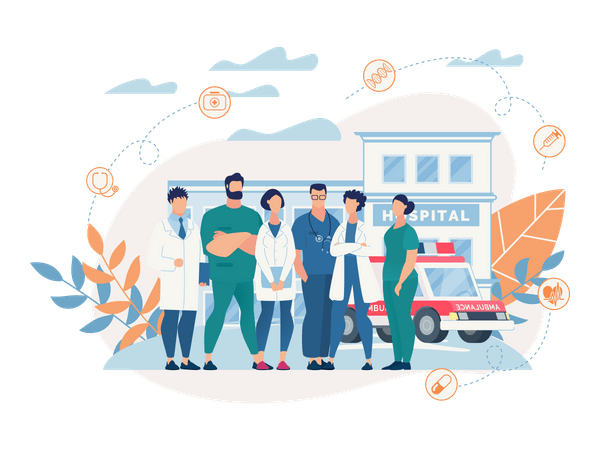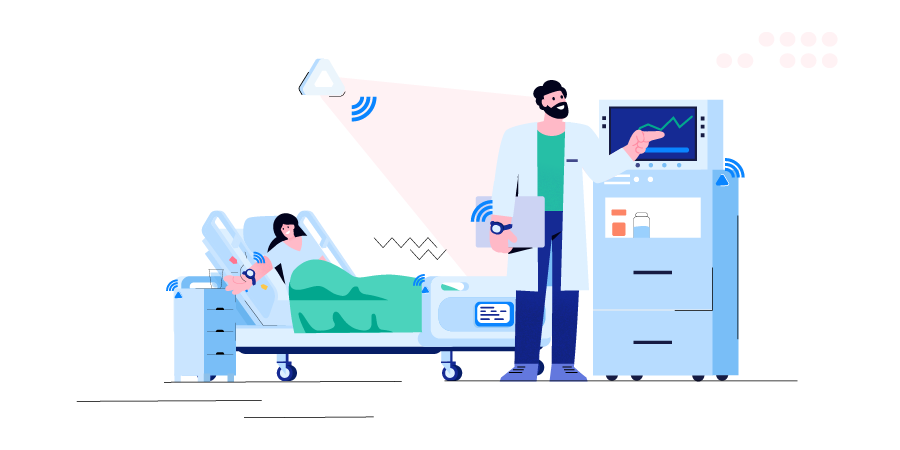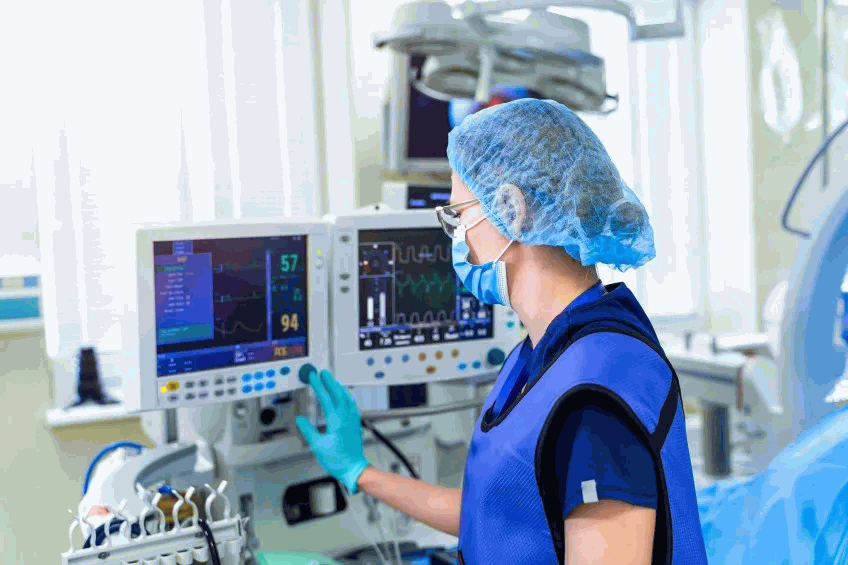Hospitals and healthcare facilities can handle a variety of equipment and gadgets with the use of asset-tracking systems. However, many systems are antiquated, unstable, and prone to errors, which adds time and money to what should be a quick procedure.
RFID asset tracking allows you to collect asset data in a fraction of the time it would take to locate your assets manually. RFID offers a fully automated and significantly more reliable method of tracking medical equipment. By utilizing it, hospitals can improve data collection, lower personnel expenses, and streamline mission-critical activities.
Recent years have seen a significant uptake of RFID technology, which employs wireless communication to identify and monitor people and equipment. In addition to asset management, other RFID use cases include enhancing patient workflow by automating previously manual processes for monitoring and scheduling operations and providing real-time information about the location of medical equipment.
Related article: Benefits of Healthcare Asset Tracking in 2022
What is RFID in Healthcare?
While RFID functions similarly to a barcode, it has certain additional advantages. Numerous tags can be read simultaneously, no direct line of sight is required for the reader to read the tag, and RFID enables each item to be identified and tallied as a separate unit.
The scanner immediately communicates to local networks or cloud-hosted software when it finds an RFID tag. That information, updated in real-time for all users, may now be shared around the firm by individuals with the required permissions. When combined with other applications such as electronic patient records and bed availability databases, the RFID-tagged patient, device, or asset can be tracked continuously, automatically, and correctly.
The Use of RFID Technology in Healthcare:
Numerous healthcare applications can benefit from the accurate, automated, and dependable data capture system offered by RFID technology. These applications can manage surgical equipment, support staff, and patient workflow while improving patient safety. RFID technology applications in healthcare include:
Identification of the right patient:
- Prevents surgery on the wrong patient
- Less time is spent waiting.
- Automated billing is possible, allowing for audits and patient care.
Pharmaceutical Traceability:
It displays the product expiration, shrinkage, and waste are eliminated by effective recall management.
Identification of the Equipment:
- RFID meets the requirements of the unique device identification system.
- Improves hygienic outcomes and reduces the need for extra equipment purchases.
Chain of Supply Inventory Management:
- Greater awareness of the inventory.
- Significantly lower equipment and supply chain costs.
- Check for product expiration and shrinkage to reduce waste.
- Method for automatic customization of inventory tracking.

Why Hospitals Are Choosing RAIN RFID for Asset Management?
You can enhance patient care, prevent employee dissatisfaction, and cut capital expenses with the aid of RAIN RFID asset management systems. For instance, 10,000 pieces of portable equipment, including everything from gurneys and wheelchairs to infusion pumps and portable monitors, are generally present at a hospital with more than 500 beds. Except when it is being maintained or cleaned, each item should ideally be in use most of the time. Because clinical departments care about keeping equipment available when needed, things are sometimes lost, put away for maintenance, or even hidden.
With a RAIN RFID-enabled solution, minute, robust tags alert readers positioned all over your hospital to the location of every piece of equipment. It enables you to determine whether something was accidentally put in the laundry, lost, or left outside the door. A comprehensive solution built on the RAIN RFID platform allows you to create a hospital-wide requisitioning system to use every asset you have when and where it is required, plan and track items for maintenance and cleaning, and more.
How RFID Solutions Improve Patient Safety and Hospital Workflow
Although radio frequency identification (RFID) is a well-established technology, new developments, and the potential to use RFID in conjunction with other technologies, such as cloud computing, have increased its usefulness. Clinical and administrative procedures in healthcare can be transformed by RFID technology in hospitals and other locations. Let’s see how RFID solutions improve hospital workflows and improve patient safety,
- RFID patient monitoring systems provide real-time visibility and control over occupancy, patient distribution, and space availability, enabling institutions to track down specific patients and safeguard those most vulnerable. As a result, patient paths and workflows are significantly more effective.
- RFID helps to avoid misunderstandings and updates/exchanges of data in real time, especially when coupled with electronic patient and administrative information. It improves planning, continuing communication, and follow-up and decreases delays and non-compliance at every stage of the patient route.
- When combined with an electronic record, RFID tags create a single shared source of truth for all clinicians and managers that can be updated at the bedside/treatment site and keeps everyone informed throughout the patient’s care and at all other points the way.
- RFID makes the automation of formerly laborious operations simple, including note transcription and conveyance, bed availability evaluation and communication, and discharge information. It reduces human mistakes and delays and dramatically improves workflow efficiency.
- Medical device traceability is completely provided via the RFID tagging of equipment. In just a few seconds, gadgets may be detected, and patients who need devices can be recognized.
- Instantaneous stock information, including use-by dates and the amount of time since purchase, is provided by RFID tagging and reading of devices and pharmaceuticals. Utilizing this will improve ordering, inventory management, and availability. Compare this to the high expense and imprecision of manually auditing and accounting for each item with RFID, which can read hundreds of tags in only a few seconds.
Benefits of RFID asset tracking in hospitals
RFID is a useful tool for automating the tracking of essential objects in hospitals. More crucially, facilities that have adopted RFID technology can gain from:
1. Enhanced Patient Safety and Equipment Tracking:
Improving patient safety through accurate tracking is one of the most critical advantages that RFID technology can offer hospitals. It comprises:
- Keeping a reliable record to ensure the proper patient receives the right medication.
- Assuring the proper cleaning and autoclaving procedures were followed with the tools.
- Directing the patients to the appropriate hospital location.
- Confirming that each patient’s room has the appropriate equipment.
2. Automatic and Precise Inventory Management:
Hospitals can automate inventory counts by carefully placing fixed RFID readers at dock entrances and entry points. With a passive system like this, your asset management software automatically updates inventory counts when tags are scanned as people pass through checkpoints or portals. Due to eliminating inventory receiving and shipping errors, hospital staff can spend less time scanning products. Additionally, it gives managers a simple method to check what the hospital received in each shipment and spot any shortfalls. However, you won’t experience those issues if your warehouse uses the same system.
3. Locate Critical Assets Quickly:
The healthcare sector cannot afford to lose time on inefficient supply and equipment searches. Additionally, hospitals do not have the financial resources to replace lost equipment continually. Installing a passive RFID system allows hospital staff to track the movement of assets across a facility and ensure their current positions. With RFID checkpoints placed at entrances, rooms, and laundry chutes, you will always have access to information about an item’s most recent location, preventing crucial supplies from going missing or ending up in the trash or waste.
4. Lower operating expenses
Final Thoughts:

RFID technology aids in automated inventory management, enabling front-line healthcare staff to access real-time inventory data, track trends, and place orders before supplies run low. It improves the patient experience by giving them more time to concentrate on patient care. Hospitals can better identify which medical equipment is underused thanks to RFID technology. It decreases the need to buy additional inventory by increasing the use rates of the present equipment.
The global usage of asset tracking solutions has reached a pinnacle in the past 20 years among businesses. It’s hardly surprising that the Manufacturing, Logistics, Retail, and Healthcare sectors are leading the way in the worldwide asset tracking market share, which is predicted to reach more than $36.3 billion by 2025, growing at 15% CAGR.
RFID asset monitoring has established itself as a “go-to” solution as businesses continue to strive for total management of their assets that are essential to their income streams.
More than ever, businesses with a high asset concentration must implement efficient asset monitoring solutions in response to growing stakeholder and consumer demands. No matter what category your business falls under—business size, kind, or industry—all goals for asset management are essentially the same.
Related article: All you need to know about Asset Management in Healthcare
FAQs:
What is RFID used for in healthcare?
RFID tags allow medical professionals to track newborns and older patients with dementia or other cognitive issues that might wander away from the facility. They also provide real-time information about the location of medical equipment and enhance patient workflow by automating previously manual processes for managing and scheduling procedures.
Is RFID safe for health?
Since it employs electromagnetic fields to automatically detect and monitor tags attached to objects, RFID technology has been widely adopted by various organizations. It makes inventory management and access control more accessible. According to research done by the World Health Organization (WHO) and many other organizations, there won’t be any detrimental health effects even if you’re exposed to RFID, such as cards or tags, for a long time. Regarding prolonged use or regular exposure, RFID-containing items are safe.























